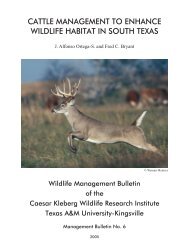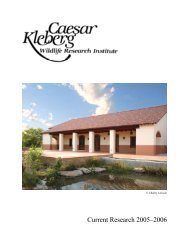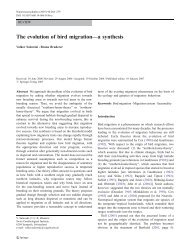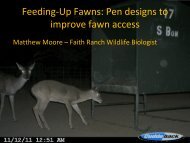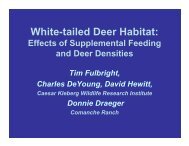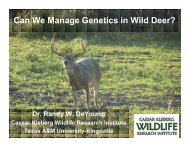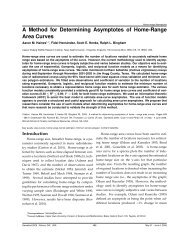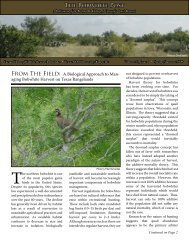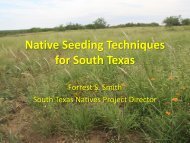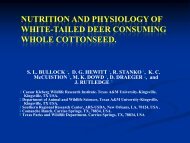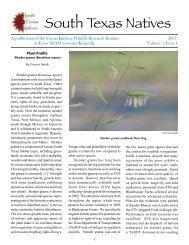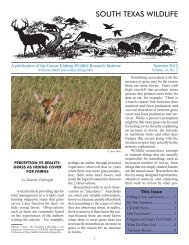The Northern Yellowstone Elk: Density Dependence and Climatic ...
The Northern Yellowstone Elk: Density Dependence and Climatic ...
The Northern Yellowstone Elk: Density Dependence and Climatic ...
You also want an ePaper? Increase the reach of your titles
YUMPU automatically turns print PDFs into web optimized ePapers that Google loves.
J. Wildl. Manage. 66(1):2002DENSITY DEPENDENCE IN YELLOWSTONE ELK * Taper <strong>and</strong> Gogan 109Table 2. Late winter age <strong>and</strong> sex composition of the northern<strong>Yellowstone</strong>lk herd, winters 1987-1988 through 1995-1996,Montana <strong>and</strong> Wyoming. Data are from records archived at <strong>Yellowstone</strong>National Park, Mammoth, Wyoming, USA.Calves: Yearling M: Adult M:Year 100 F 100 F 100 F n1987-1988 23 4 15 5,1031988-1989 6 2 13 2,8271989-1990 19 3 12 3,3931990-1991 26 - - 1,9251991-1992 44 - - 3,5301994-1995 33 11 29 3,6131995-1996 28 9 26 2,902of elk numbers for winters 1986-1987 through1990-1991 by adjusting numbers to account forthe proportion of radiocollared elk that were notseen during the st<strong>and</strong>ard aerial censuses.Coughenour <strong>and</strong> Singer's (1996) calculationsindicate that even in good survey years, aerialcensuses post-1986-1987 underestimate the populationlevels on the order of 25%. However, forthe 1988-1989 <strong>and</strong> 1990-1991 censusesCoughenour <strong>and</strong> Singer (1996) believe that only49 <strong>and</strong> 51% of the population was counted,respectively, confirming the census participants'assessments. We reduced the Coughenour <strong>and</strong>Singer (1996:574) corrected estimates for1988-1989 <strong>and</strong> 1990-1991 by 25% to make themcomparable with the rest of the count data.Early <strong>and</strong> Late Periods<strong>The</strong> census data do not form a continuousrecord. No population estimates were made during1980, 1981, 1983, or 1984. Consequently,growth rates are not available from 1979 to 1984.This divides the time series into an early (i.e.,1964-1979) <strong>and</strong> a late (i.e., 1986-1995) period.Adjusting for HuntingBecause our intent was to investigate the naturalregulation of the northern <strong>Yellowstone</strong> elkherd, we corrected for hunting to discern theunderlying natural population dynamics regardlessof whether hunting is density-dependent ordensity-independent. <strong>The</strong> annual elk cycle in <strong>Yellowstone</strong>begins with calving in spring, resultingin a population increase (Fig. 1). Perinatal mortalityreduces the population size somewhat(Singer et al. 1997), <strong>and</strong> then the populationenters a period with comparatively low naturalmortality until late winter (Green et al. 1997).Superimposed on this cycle are annual total herdcounts at the beginning of each year <strong>and</strong> annualhunting mortality. This population is subjectedto a regular-season hunt <strong>and</strong> a late-season hunt.<strong>The</strong> regular hunt has occurred between lateOctober <strong>and</strong> late November since the mid-1960s(Erickson 1981). <strong>The</strong> late hunts have varied fromlate November through early March during themid-1960s, mid-December through mid-Februaryduring the early 1980s, <strong>and</strong> earlyJanuary to mid-February during the 1990s (Erickson 1981,Lemke et al. 1998). Thus, the count <strong>and</strong> mosthunt mortality occur during a period of low naturalmortality. This allows us to study densitydependence in this herd as it would haveoccurred in the absence of hunting. We calculatea pre-hunt population estimate by adding all legalharvest plus known illegal kills <strong>and</strong> lost woundedanimals presumed to have died that occurredbefore the annual count to the estimated herdsize (Lemke et al. 1998). In a similar fashion, apost-hunt population estimate is constructed bysubtracting known subsequent anthropogenicmortality from the census (Table 1). We investigatednatural population regulation by studyingthe statistical dependence of transitions in populationnumbers from post-hunt to pre-hunt thenext year on post-hunt population size.Correcting for Range Expansion<strong>Density</strong> dependence by definition relatesgrowth rates to population densities. Calcula-tions based on raw population counts will not bevalid if range expansions or contractions occur.<strong>The</strong> winter range for the northern <strong>Yellowstone</strong>elk herd increased during the early 1980sPre-huntestimatez Z I /_ \6iPerinatal mortalityAerialcount Post-huntestimateCalving Early Latehunt huntWinter mortalityMay Jul Sep Nov Jan Mar MayJun Aug Oct Dec Feb AprFig. 1. Schematic diagram of annual cycle of elk numbers, timingof natural <strong>and</strong> human-induced mortality <strong>and</strong> sampling,northern <strong>Yellowstone</strong>lk herd, Montana <strong>and</strong> Wyoming.



